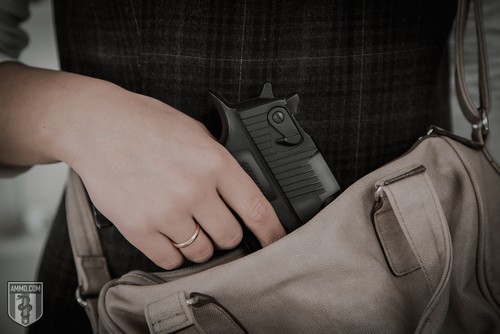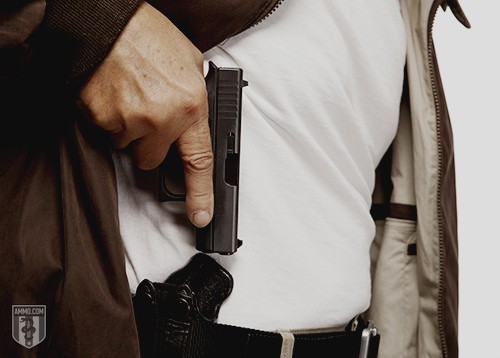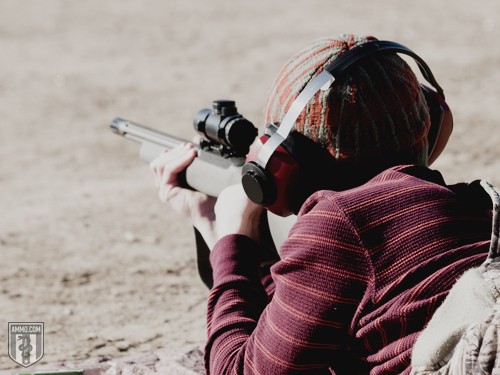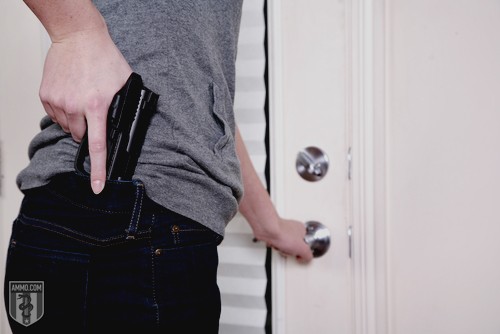Protecting Your Family: A Smart Parent’s Guide to Self Defense and Concealed Carry (CCW)
You're free to republish or share any of our articles (either in part or in full), which are licensed under a Creative Commons Attribution 4.0 International License. Our only requirement is that you give Ammo.com appropriate credit by linking to the original article. Spread the word; knowledge is power!
 Parenting comes with a lot of hard decisions. From bottle or breastfeeding to public or private schools, it can feel like every decision you’re faced with will make or break your child. And when it comes to protecting and defending your family, the decisions get even tougher.
Parenting comes with a lot of hard decisions. From bottle or breastfeeding to public or private schools, it can feel like every decision you’re faced with will make or break your child. And when it comes to protecting and defending your family, the decisions get even tougher.
In the United States of America, the Second Amendment ensures your natural right to defend your family with the use of firearms. Yet some argue that keeping guns around children puts them at a greater risk than it protects them. This is why, for many, making the decision to keep guns in the home is a big one. Because while it allows you an incomparable defense option, it could also lead to your child’s little hands on a deadly weapon.
Remember, you are responsible for the safety and well-being of your children. And since guns are found in more than one-third of all American households – even if your family doesn’t have them, chances are your child will visit a house that does. One way or another, kids learn about firearms. It’s your responsibility to make sure you’re the one teaching them.
Jump to our special note for foster and adoptive parents.
Demystifying Firearms
One of the reasons kids are drawn to firearms is the same reason they’re drawn to drugs, alcohol, and séx – because it’s taboo. That’s why demystifying guns is a necessary feat, for both parents who keep guns and especially for those who don’t.
When you teach children about guns, when they see you take them apart, clean them, put them back together, when they learn how they work and what they do – firearms lose their mystery. They become a tool and a weapon, but are no longer shrouded in the vague “dangerous and deadly.”
To make this happen, you need to make guns (or at least talking about guns) a part of your regular routine. These gun talks can’t be isolated events. The message needs to be reinforced over and over again to take root and to actually become effective when the child’s presented with a gun situation.
If you’re unsure where to begin, ask your child what he or she knows about guns, and ask if there are any questions. See what the response is and go from there. Also make sure your child understands certain realities about firearms. To ensure this happens, be sure to discuss the following:
- The difference between toy guns and real guns.
- The difference between guns on television and guns in real life.
- The devastation and destruction guns can cause.
Talking to your kids about firearms works, but studies show that people without guns in their home are less likely to regularly do so, and up to 50 percent of non-gun-owning citizens NEVER talk to their children about guns. These are the kids that don’t understand guns, how they work, and the real danger playing with guns can create.
Gun Safety Must Come First

Gun safety, especially when it comes to children, is a big deal. In 1999, 3,385 children aged 19 and younger were killed by a gun – including homicides, suicides, and unintentional injuries. Regardless of your position on guns and gun control, people can agree that’s way too many.
One of the main reasons so many children were killed is because parents, and people who have children in their homes, aren’t always practicing safe and secure gun storage.
In nine percent of homes that contain both children and guns, there is at least one firearm that is loaded, but not secured. You read that right, unsecured and loaded. That’s nearly one in 10. And it’s not okay.
If you opt to keep guns in your home, you give yourself the ability to protect those you love the most. But you’ve got to keep them safe. Here’s how you can achieve both:
- Keep your gun locked and unloaded.
- If you feel the need for a loaded weapon at home, keep it on your person.
- Store ammunition in a different location.
- Keep gun safe keys away from commonly used keys.
- Children should not know where guns are stored.
A gun that is unloaded, but has a full magazine beside it in your bedside drawer, is not a secure gun. Don’t store your firearms this way.
Keeping Guns Safe with Technology
While it’s important to teach your kids about gun safety, you can also use technology to help keep your guns secure. New, smart gun technology is becoming available and includes a fingerprint scanner to unlock and be able to fire the gun. Also available soon is grip recognition technology that determines an authorized gun user by the muscle tension in the gun holder’s hand.
Another interesting concept for gun safety is the RFID token, which if not within a certain proximity to the gun, will not allow it to fire. The token can be incorporated into a ring or bracelet, so unless the firearm is in the owner’s hands, it won’t fire.
Teaching Kids about Gun Safety
Gun safety goes beyond securing your weapons. Kids need to understand what to do if they ever come across a gun, because if you don’t teach them, they’re going to try to figure things out on their own – and that can quickly turn deadly.
Teach children to always assume the following:
- All guns are loaded.
- Pointing a gun at something means you want to destroy it.
- Never touch the trigger until you’re ready to shoot.
- Be 100 percent sure of your target and what’s beyond it.
If your child has play guns of any sort, from Nerf to airsoft to paintball, uphold gun safety rules with these “toy” guns as well. This teaches them to always treat guns with respect, even when they’re not quite “real.”
Gun Safety Programs
There are multiple gun safety programs out there to help your children understand the importance of gun safety. The NRA’s Eddie Eagle Gunsafe Program teaches children in Pre-K through third grade about gun safety by giving kids four easy steps to remember. The first, when you see a gun, you need to stop what you’re doing. Second, don’t touch the firearm. Third, leave the area. And fourth, go tell an adult about the gun.
The ASK campaign, which stands for Asking Saves Kids, revolves around the idea of asking one question to all of your children’s friends before letting your child visit: Is there an unlocked gun in your house? This question allows you to be aware of who has firearms and to make sure your child is educated and prepared to visit. By asking this one question, you’re also encouraging parents to lock up their firearms securely – because, really, what parent of a five-year-old wants to admit they have an unlocked weapon lying around?
And if you have teenagers, be extra diligent. Research shows that parents of teens are less likely to secure firearms. And the vast majority of the above-mentioned shootings happen when teenagers get their hands on a gun.
Teaching Kids to Handle Guns
Children who are taught to handle guns the appropriate way and to understand when and where it’s okay to use firearms are less likely to play with guns or use them in unsafe places. These children understand the importance of gun safety and know the damage guns can create, therefore they’re less likely to handle them unauthorized.
Once your child reaches the appropriate maturity and size, typically around age eight, you can start teaching the basics of gun handling. Here’s how:
Take a Class

- The Jaycees
- 4H Shooting Clubs
- NRA Youth Shooting Programs
Daisy and over 2,000 US Jaycee chapters offer supervised gun handling classes to boys and girls ages 10 to 14. These classes teach children proper gun handling, as well as marksmanship. Over 250,000 kids partake in the program, which has both state and regional competitions.
Four-H programs throughout the country offer shooting sports programs, which work with children to teach them about gun safety, proper handling, and marksmanship.
The NRA offers a variety of youth programs, including challenges, events, and educational courses. Contact your local chapter to learn more about what’s available in your area.
Practice at Home
Before, during, and after taking a class, children need to practice handling firearms for mastery to occur. Therefore, it’s absolutely necessary for them to practice at home on a regular basis. Here are some ways to work on gun handling and safety at home.
- Shoot fruit: By shooting cantaloupe, honeydew, and watermelon, kids are able to visualize the reality of the force behind a firearm.
- Start with a small caliber: While your child might want to handle the “big” guns, start with a small caliber gun. A beginning shooter should always focus on building shooting skills with a gun that doesn’t have handgrip or recoil issues. This allows the shooter to build skill without having to fight against the gun.
- Have them watch: After shooting, make sure to show your child how to take the gun apart, clean it, and put it back together. This teaches the importance of proper gun maintenance.
- Always follow the rules: When you’re an adult who’s been shooting for years, it’s easy to forget the safety precautions you should be using. If you’re shooting with a child around, don’t take shortcuts. Be safe and teach them the right way to handle firearms.
To Carry or Not to Carry
Concealed carry is a hefty responsibility, and if you’ve got children, it’s even more so. And while many may criticize those who opt to exercise the right to carry concealed, there are many reasons to keep a firearm on your person when out with the family.
First, you obviously want to protect those you love. And there’s no better protection from violent attackers than a concealed carry weapon. Second, when you have children, you’re ability to flee from an attacker severely lessens. Children slow you down, and your gun can quickly become your family’s only defense.
Once you’re a parent, you have more of a reason to defend yourself than ever before. The challenge is that you must find something safe, that children can’t reach, but you can – and quickly. More than that, you must be able to keep the concealed carry weapon hidden, as discretion is a must at playgrounds and preschools.
Concealed Carry Considerations for Packing Parents
If you’ve decided to carry concealed, it’s time to think things through. There’s information out there that teaches women how to carry while wearing a bodycon dress, about how to carry concealed when you’re in a wheelchair, and what business professionals can do to ensure their firearm isn’t visible during a board meeting.
Yet no one tells you how to carry concealed when you’re a parent, when you’re juggling two diaper bags, a toddler, and a screaming baby on your hip. How are you supposed to have a loaded gun on you when you’ve got children pulling at your shirt, climbing over your back, and reaching their little grubby hands into your pockets?
Where to Carry
If you can, carrying on your person is always best. It keeps the gun close, safe, and lowers the risk of someone seeing it and taking it from you. The most common place to carry is on the dominate hip, yet that happens to be the same place you’re likely to carry a child. Don’t do both. Double stacking is uncomfortable for both you and junior, plus it makes it nearly impossible to quickly and effectively grab your gun in an emergency. Instead, learn to carry your child on your non-dominant hip. It leaves your gun and your primary shooting hand available, and will help to strengthen your weaker side.
A second option is to learn to wear your baby. When you wear your child instead of carrying him or her, it can be quite beneficial. Your child is securely against you and you know right where she is. She can’t get away, run in front of you while you’re shooting, or get scared and hide. It also gives you the ability to use both hands while firing, which boosts your comfortability and control.
Holsters
When it comes to concealed carry holsters, you need to think beyond the hip when you’ve got kids. The best bet for parents is typically a shoulder holster, worn under your weak side arm. This keeps your gun out of the way, but easily accessible.
If your children are still at an age where they get carried, make sure your holster has a complete trigger cover. You don’t want wandering hands to find it under your shirt and accidentally squeeze the trigger, firing the handgun.
To keep the gun and holster hidden, be sure to wear loose, long shirts to ensure your firearm stays concealed. Patterns and floral prints work best to cover bulges that the holster and gun may create.
Concealed Carry Bags
If you decide to carry your weapon in a bag, opt for a specially designed concealed carry purse, briefcase, or bag. Don’t just throw your handgun into your purse and think that’s okay. It’s not. First, a normal bag or briefcase isn’t designed to keep a gun securely in place. The firearm bounces around, gets pressed against things, and moves. Little bits of dirt and debris, and probably small pieces of crackers and little Legos all could get jammed in the barrel, and can cause a misfire.
Also, never set your bag down with the concealed weapon in it. Not in the grocery cart at the store and not on the kitchen table at home. A gun that is not on your person is not secure, regardless of what kind of bag it’s in.
If you decided to opt for a concealed carry bag, carry a revolver instead of a semi-automatic. If you would ever have to shoot through the bag, it doesn’t have enough room for a semi-automatic to eject the bullet. Choose a revolver to guarantee you and your family stay safe.
Practice, Practice, Practice

When it comes to carrying concealed and using a weapon in self-defense, especially with children in tow, you have to practice. And then practice some more. Practice all the time. And don’t just do it at the range. Do it at home. Dry run in the places you visit often. Think about different situations that could arise when you’re with your children at the mall, at home, and at school. Now prepare for those situations. What would you do? Where would you be? Are you carrying your child? Is he in a stroller? What about if you’ve been hurt and are on the ground? What if you’ve been grabbed and the attacker has your dominate hand? Can you shoot with the other?
Practice and prepare for every situation that can arise, that way, no matter what, you’ll be ready.
A Special Note to Foster and Adoptive Parents
If you’ve opened up your home, heart and family to foster children, or are considering adoption, there may be gun laws to consider. In certain states, your Second Amendment rights could be sacrificed to foster children or to become an adoption candidate.
In Oklahoma, foster families and prospective adoptive parents must sign a Weapon Safety Agreement. Among other things, this agreement states that if there is a gun present in the home, the firearm must be kept unloaded in a locked storage container with ammunition stored in a different locked container. The agreement also states that a concealed firearm is not allowed in a vehicle with the potential foster child, and only those who are mandated by their employer are able to carry concealed while the child is present.
In Illinois, potential foster families must either certify that there are no firearms in the home or complete the Foster Family Firearms Arrangement. As part of this arrangement, families must list all guns, ammunition, and locations where they are kept within the home and are subject to involuntary home inspections. All firearms must be kept locked and the key must be carried on an adult or be kept off the premises.
In New Jersey, foster parents are permitted to have firearms and weapons as long as that they are locked securely in an approved steel gun vault that is separate from the ammunition for those firearms (which must also be locked away).
In Michigan, potential foster families must store firearms in a locked safe, separate from locked-away ammunition. And all handguns must be registered.
Even though there are children in desperate need for responsible, law-abiding families to love them, protect them, and keep them safe from harm, people are being denied the opportunity to arm themselves – even though they have never broken the law or been arrested. Instead, they’ve gone through background checks, often taken gun safety courses, and obtained their concealed carry permit through legal processes, only to be told they’re not allowed to be foster parents or to adopt regardless of their Second Amendment rights.
General Self-Defense Tips
- Get loud.
- Stay out of reach.
- Your goal is always to get away.
- Never go with an attacker.
- Be aware of your surroundings.
- Don’t put yourself in high-risk situations.
- Teach your children about self-defense and protection.
- Be mindful of places like airports or courthouses that tend to have a hefty security system and usually contain security wand metal detectors.
5 Recommended Firearms for Safety-Conscious Parents
When it comes to concealed carry, there’s a few things to remember. You want a firearm that you’re comfortable with and that you can easily conceal. You want to make sure that it’s small enough to control easily, but that it also has enough stopping power to halt an attacker.
Here are five recommended firearms for parents with safety in mind:
- Glock 26 or the Glock 27: Small enough to carry and conceal, both the Glock 26 and 27 have a punch big enough to stop an attacker, are reliable, and are easy to handle.
- Smith & Wesson M&P Shield: A scaled-down version of the S&W Duty line, this handgun is available in both a 9mm and a 40 S&W. It’s small enough to conceal and control, but is still deadly.
- Ruger LC9: Less than an inch across, the Ruger LC9 is small and easy to conceal. And since it’s available in both 9mm and .380, it gives you power options as well.
- Beretta Nano: While the Beretta Nano make looks a little different, it’s great as a concealed carry weapon because there’s nothing to get caught on your clothing or bag when you pull it out of its holster.
- Smith & Wesson Bodyguard .38: If you’re looking for a revolver instead of a semi-automatic pistol, consider the S&W Bodyguard. With a built-in laser sight and its double action mechanisms, this gun makes you feel safe and comfortable.
It’s No Longer Just About You
When you become a parent, it’s no longer just about you. It’s about the children. And you need to do everything you can to protect them. While some may baulk at the idea of carrying a weapon to protect a child, the fact remains that to an attacker, you look more like a victim when you have a child in tow. The attacker believes you’re less likely to have a gun and less likely to defend yourself.
It’s time to prove them wrong. Carrying concealed does more than just protect you. It allows you to protect the things you care about most – your children.
Self Defense
- Arming Yourself: A Woman's Guide to Self Defense and Concealed Carry (CCW)
- Protecting Your Family: A Parent's Guide to Self Defense and Concealed Carry (CCW)
- Arming the Elderly: A Self-Defense Guide for Senior Citizens
- Holsters for Self Defense: A Guide to Carrying Concealed
- Arming Toddlers and The "Kinder-Guardians" Program: A Shamefully Bad Idea
- Handgun Wounding Factors: A Caliber Effectiveness Guide for Self Defense and Body Damage
- Self Defense for LGBT: Self-Protection and Concealed Carry (CCW) for the LGBT Community
- Arming the Disabled: A Self-Defense and Concealed Carry Guide for People With Disabilities
